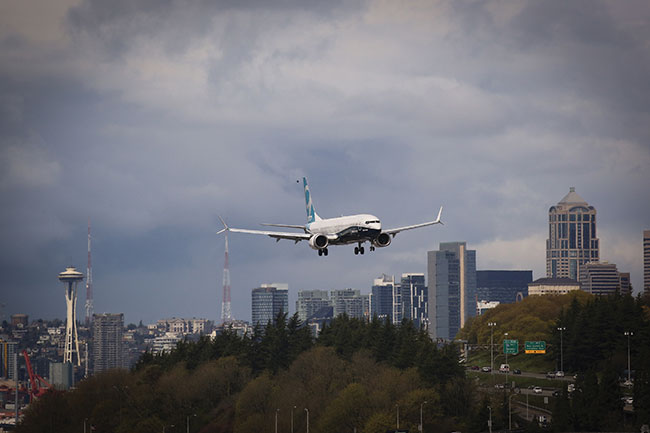
Features
Aircraft manufacturers
Alternate Approach: Who’s minding the store
Boeing faces more challenges and scrutiny after Alaska Airlines blow out
February 6, 2024 By David Carr
 The FAA is exploring the use of a third party to oversee Boeing’s inspections and quality systems. (Photo: Boeing)
The FAA is exploring the use of a third party to oversee Boeing’s inspections and quality systems. (Photo: Boeing) How many more hits to its reputation can Boeing absorb? At press time, it was too early to say who is directly responsible for an Alaska Airlines 737 Max 9 emergency door plug popping out from the fuselage at 16,000 feet. But a consensus has formed. Boeing has a quality control problem.
“[T]he dramatic nature of the flaw will have the effect of once again calling Boeing’s product governance into question by customers, regulators and the flying public,” Nicolas Owens, an analyst with Chicago-based Morningstar Inc. told Reuters news agency.
The Alaska Airlines setback came as confidence in the Max program was gradually being restored. Boeing sold 883 Max airplanes last year, including an order from Lufthansa, the launch customer for the original 737 in 1967, and who hasn’t operated the type since 2016. Dave Calhoun, Boeing’s chief executive since 2020, has worked to rebuild Boeing’s reputation for reliability and engineering excellence, while so-called ‘quality escapes’ dog the effort.
Boeing delivered 528 airplanes last year. An improvement over 2022, but short of its target. Sloppy production over vertical stabilizer fittings and mis-drilled holes in aft-pressure bulkheads supplied by Wichita-based Spirit AeroSystems disrupted deliveries of some Max airplanes, leaving costly inventory sitting on the ground while Boeing repairs and inspects the airplanes in question.
Spirit also supplies the fuselage and door plugs for the Max 9, including the Alaska Airlines ill-fated aircraft that had been in service for about eight weeks. Since the airplane was grounded, United and Alaska Airlines, the two largest operators of the type, have found loose bolts related to the installation of door plugs in a number of Max 9s. Spirit replaced its chief executive with a former Boeing executive and pentagon official in October.
Boeing’s stock plunged almost 10 per cent after the Alaska Airlines incident. It will rebound, just as it did after the 737 Max was grounded in March 2019 and before COVID hit. But the stock has never regained its pre-grounding value while the gap between Boeing and Airbus for orders widens.
It is estimated that Boeing has paid out approximately US$20 billion in fines, penalties to airlines, and compensation for the families of the victims of the Lion Air and Ethiopian Airlines Max 8 tragedies. The overall bill for 737 liabilities is about to grow higher and faster. But the hit to Boeing runs deeper than financial. Boeing and Spirit AeroSystems are under intense scrutiny. At the time of writing, the Max 9 grounding had entered its third week and the Federal Aviation Administration (FAA) has cast a wider net by recommending operators of the 737 900ER “visibly inspect” their fleets. The 737 900ER, which entered service in 2016, shares a door plug design with the newer model.
An initial batch of 40 fully inspected Max 9s still needs to be re-inspected before the FAA will review the results. “The safety of the flying public, not speed, will determine the timeline for returning the Boeing 737 9 Max to service,” the administration said in an earlier statement. The FAA is also considering third-party oversight of Boeing’s production lines, and has launched an investigation into what went wrong. Alaska Airlines has announced a “thorough review” of Boeing’s quality control systems, and European low-cost operator Ryanair has doubled its oversight of Boeing’s production.
For its part, a shaken Boeing has admitted its “mistake”. To help right the ship, the company has appointed a retired U.S. Navy admiral to lead an in-depth assessment of its commercial quality management system.
Boeing was always an engineer’s company that shaped the great leaps in modern day air transport. The company brought to market four groundbreaking jets between 1958 and 1970 alone.
When Airbus bet big with the A380, Boeing changed the game again with the 787. Boeing may not have lost its way completely, but it clearly has lost its ambition to lead. Shortcutting a new generation airplane out of a 40-year-old airframe was one squeeze too many. The company’s next new airplane will likely compete in the single-aisle category, but is not expected to be launched before 2030.
There is still confidence in the Boeing product line, including a strong rebound in wide-body sales. Still, the company has little margin for error, especially when it comes to the Max. According to the U.K.’s Telegraph newspaper, Calhoun told staff at a meeting after the grounding that Boeing would “ensure every next airplane that moves into the sky is in fact safe.” That used to be a given.
David Carr is former editor of Wings and Helicopters magazines.